MARIANI’S
May
20, 2007
NEWSLETTER
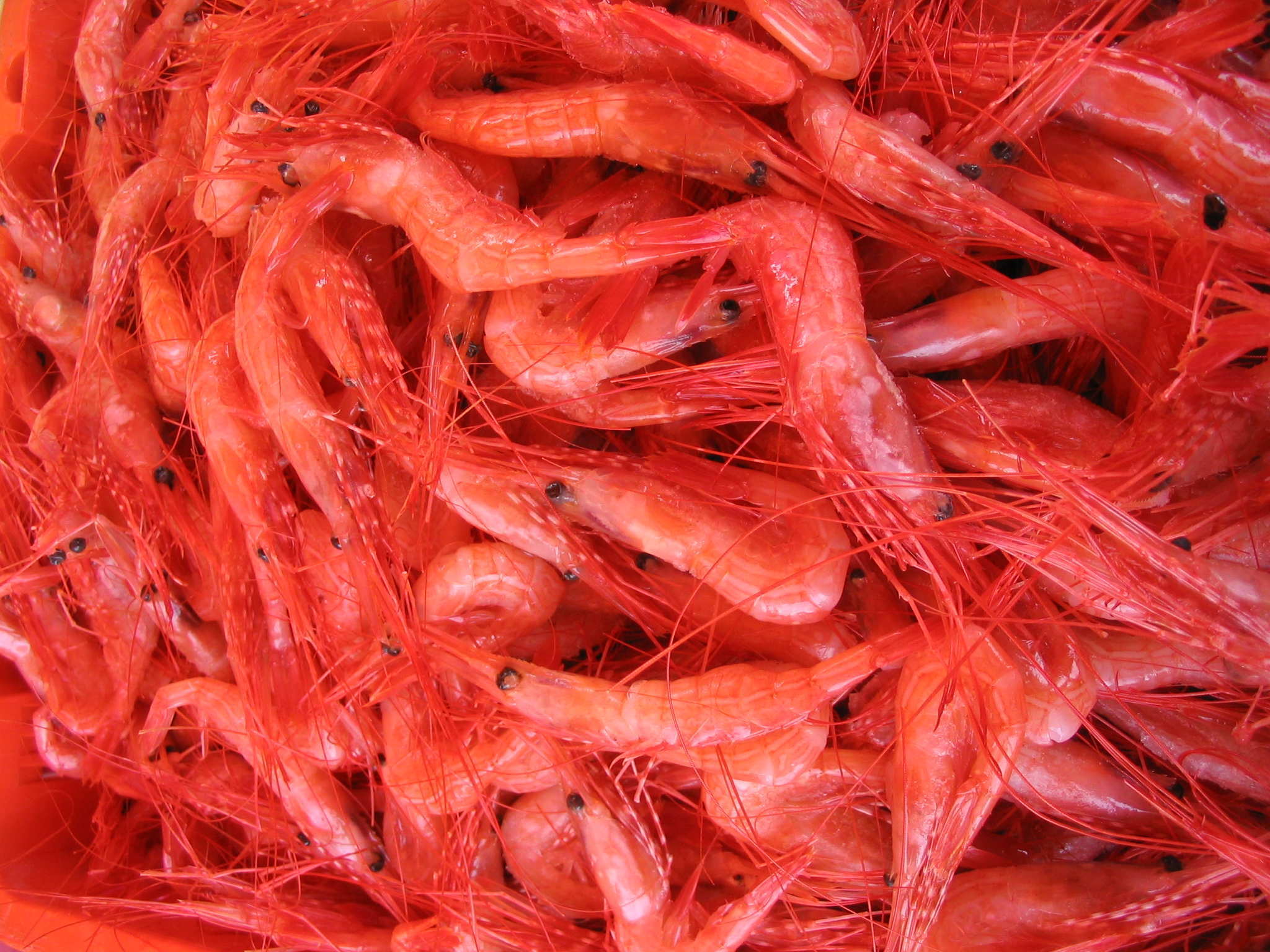
Red Shrimp, Chinatown Vancouver, British Columbia (2006)) by Galina Stepanoff-Dargery
WEBSITE: To
go to my web site, in which I will update food
&
travel information and help link readers to other first-rate travel
& food sites, click on: home page
ARCHIVE: Readers may now access
an
Archive of all past newsletters--each annotated--dating back to July,
2003, by simply clicking on www.johnmariani.com/archive
SUBSCRIBE AND
UN-SUBSCRIBE: You may subscribe anyone you wish
to this newsletter--free of charge--by
clicking here.
In
This Issue
NEW YORK CORNER: Insieme by John Mariani
NOTES FROM THE WINE CELLAR: Choosing the House Wine in
by John Mariani
QUICK BYTES
~~~~~~~~~~~~~~~~~~~~~~~~~~~~~~~~~~~~~~~~~~~~~~~~~~~~~
OUR FAVORITE ISLANDS: MADEIRA
by John and Galina Mariani
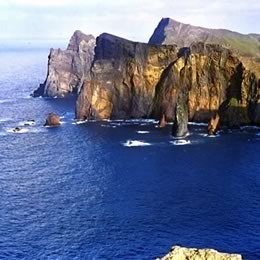 Does
anyone remember that pathetic song by the Limeliters, "Have Some
Madeira, My Dear," with the repellent lyrics about a lecher who invites
a
17-year-old girl to his room for a glass? We suspect that's the
only familiarity most Americans have with the spirit named after the
beautiful Portuguese island of Madeira.
Does
anyone remember that pathetic song by the Limeliters, "Have Some
Madeira, My Dear," with the repellent lyrics about a lecher who invites
a
17-year-old girl to his room for a glass? We suspect that's the
only familiarity most Americans have with the spirit named after the
beautiful Portuguese island of Madeira.Certainly the marvelous spirit called Madeira, which marries the backbone of Sherry to the lushness of Port, deserves its reputation among connoisseurs, although it is not as widely drunk in the U.S. as when our Founding Fathers knocked it back on a regular basis and continued to do so well into the 19th Century. As a fortified wine, Madeira has the virtue of keeping its character and not going bad even weeks after being opened. With cheese, chestnuts, and cornmeal-based cookies, it is an exquisite spirit whose fans can debate the distinctions among Sercial (the driest), Verdelho, Rainwater, Bual, and Malmsey (the sweetest).
Yet the island of Madeira itself, with its offshore planet island Porto Santo, has its own blend of Iberian culture combined with a connection to Africa's sea and winds that has always distinguished itself from Portugal proper, whose sailors settled here around 1419. The Romans, who called these the "Purple Islands," were familiar with them a millennium before, and its considerable distance from the mainlands of both Portugal and Africa have protected Madeira from the agonies of nation building that plagued the continents throughout the 19th and 20th centuries.
Madeira's five centuries' old capital, Funchal, takes its name from the abundance of wild fennel, and it is quite a beautiful, if rather crowded, city at the mouth of the harbor and rises to 1,200 meters, the top of which is reached by a gondola that drops you off at the circuitous Botanic Garden park and allows for grand views of the territory below and the sea beyond.
In Funchal itself, with about 100,000 inhabitants, the streets closer to the waterfront are wonderful for strolling, with the ‘Sé’ Cathedral (dating to the early 6th century) a quite magnificent sight whose size and details again pulls one to ask how such a huge structure was constructed on an island more than 500 miles from Portugal. The Old Town is quaint, if not particularly exciting, but, while tight with tourists in the full season, Funchal has maintained its particular character while accepting, rather than pandering to, tourists. There are good art museums, a photographic museum, two wine museums, including one devoted to Madeira wines, a sugar museum, even an embroidery museum, and 16 gardens.
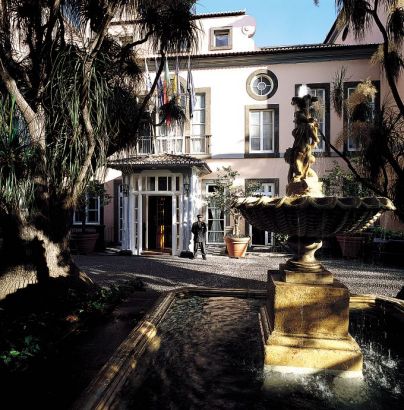
The most famous hotel on the island, where we stayed, is Reid's (Estrada Monumental 139; 351 291 71 71 71), whose rich history took root when a 14-year-old cabin boy named William Reid came to the island in 1836 to make a fortune in the wine trade, then began buying hotels that would include the one named after him. He fashioned it for the wealthy international crowd that had the leisure to summer on the island, and so landscaped the hotel with tropical flora, choosing George Somers Clarke, who’d designed Shepheard’s Hotel in
 Reid’s became famous as an exclusive
resort that welcomed everyone from Empress Elizabeth I of Austria and
George
Bernard Shaw (left), who said
that his tango instructor at Reid’s was “the only
man who
ever taught me anything,” to John Huston and Gregory Peck, during the
filming
of “Moby Dick.” In 1937 the Blandy
family bought the hotel, added to it, and worked to attract the
upper-class
British trade, many of whom did business with the Blandy’s
Reid’s became famous as an exclusive
resort that welcomed everyone from Empress Elizabeth I of Austria and
George
Bernard Shaw (left), who said
that his tango instructor at Reid’s was “the only
man who
ever taught me anything,” to John Huston and Gregory Peck, during the
filming
of “Moby Dick.” In 1937 the Blandy
family bought the hotel, added to it, and worked to attract the
upper-class
British trade, many of whom did business with the Blandy’s Today Reid's is as modern in its amenities as any of the fine hotels in Europe: there are 163 rooms, three swimming pools, and ten acres of gardens. The rooms are beautifully and individually appointed, and the quiet management of the place makes it seem like you are far, far away from a capital city, especially as you look down upon the harbor at twilight.
There are several restaurant options, beginning with the formal Dining Room, which has dancing on Saturdays and a Champagne Brunch
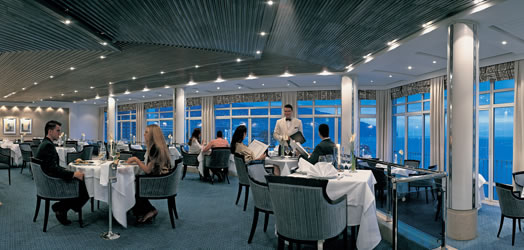 on
Tuesdays. Les Faunes (below) is
only slightly less formal (jackets required for gentlemen) but has a
lovely panorama on the ocean. It even has something of the look of an
oceanliner's dining room, and serves a kind of updated
continental cuisine, with a few flourishes like pumpkin tortelloni with
a timbale of zucchini, a quail salad, and wild boar ham done in a
turban of phyllo pastry, The winelist proudly showcases
Portuguese label.
on
Tuesdays. Les Faunes (below) is
only slightly less formal (jackets required for gentlemen) but has a
lovely panorama on the ocean. It even has something of the look of an
oceanliner's dining room, and serves a kind of updated
continental cuisine, with a few flourishes like pumpkin tortelloni with
a timbale of zucchini, a quail salad, and wild boar ham done in a
turban of phyllo pastry, The winelist proudly showcases
Portuguese label.Brisa do Mar serves French cuisine, and breakfast is at a buffet of daunting proportions at windswept Garden Room. Reid's has also capitalized on the Cipriani name (the hotel's owners, Orient-Express, also have the Cipriani in Venice in its portfolio) to create a charming, more casual, Italian restaurant with pretty tiled walls and red-checkered tablecloths that will put you in mind of those at New York's `21' Club (which Orient-Express also owns).
 We didn't have time to dine around
Madeira's local restaurants very much, but most seem to be
serving the
kind of modest menus you'll find all over Portugal, with an emphasis on
seafood. We did, however, have the chance to visit a restaurant
that would be unique anywhere--Choupana Hills Resort & Spa (Travessa do Largo da Choupana;
351-291-20-6020), located up a winding series of roads only
a good taxi driver from Funchal could possibly negotiate. As we
zigzagged up through the tropical foliage of the hillside, we came to a
dark place with soft lighting in the distance. Upon arrival we
were struck by the completely unexpected architecture of what seemed
more like a Southeast Asian island outpost (left), with 34 bungalows (58 rooms
and four suites) on pillars arrayed against the hillside. The
inspiration for French architect Michel de Camaret's design were the
colonies the Portuguese once owned and traded with in Africa and the
Pacific, using mainly wood and stone and wonderful lighting to cast a
real magic over the premises. Looking down from the pool
area (below) towards
Funchal and the Atlantic is one of the loveliest sights in Europe.
We didn't have time to dine around
Madeira's local restaurants very much, but most seem to be
serving the
kind of modest menus you'll find all over Portugal, with an emphasis on
seafood. We did, however, have the chance to visit a restaurant
that would be unique anywhere--Choupana Hills Resort & Spa (Travessa do Largo da Choupana;
351-291-20-6020), located up a winding series of roads only
a good taxi driver from Funchal could possibly negotiate. As we
zigzagged up through the tropical foliage of the hillside, we came to a
dark place with soft lighting in the distance. Upon arrival we
were struck by the completely unexpected architecture of what seemed
more like a Southeast Asian island outpost (left), with 34 bungalows (58 rooms
and four suites) on pillars arrayed against the hillside. The
inspiration for French architect Michel de Camaret's design were the
colonies the Portuguese once owned and traded with in Africa and the
Pacific, using mainly wood and stone and wonderful lighting to cast a
real magic over the premises. Looking down from the pool
area (below) towards
Funchal and the Atlantic is one of the loveliest sights in Europe.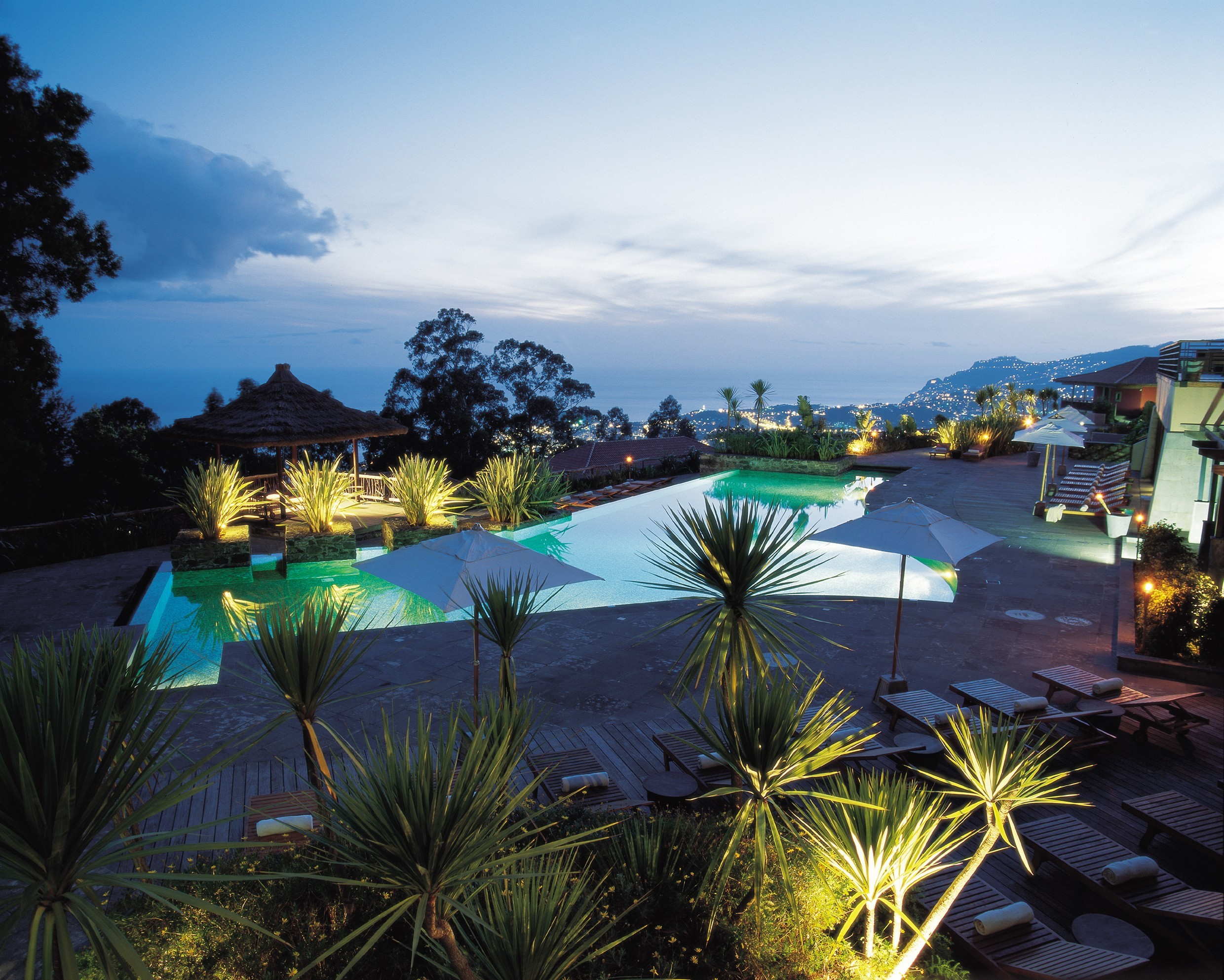
The rooms are airy, capacious and done with individual decors of rich colors and simple, but refined lines. Ceilings may be nave-like, beds canopied, and all around you are marvelously maintained tropical plants, trees, and ferns. Quiet rules the resort, and there is a first-class spa here where all the usual modern treatments are provided, including a Turkish steam bath. There are also buses that ply the hill back and forth to town several times a day.
The restaurant here is called Xôpana, set on two levels, with huge glass windows,and it is equally as handsome as the rest of the property, with superb use of vaulted woodwork and plum, red, and green fabrics, a sexy Basalt bar (left) and tables overlooking the mountainside.
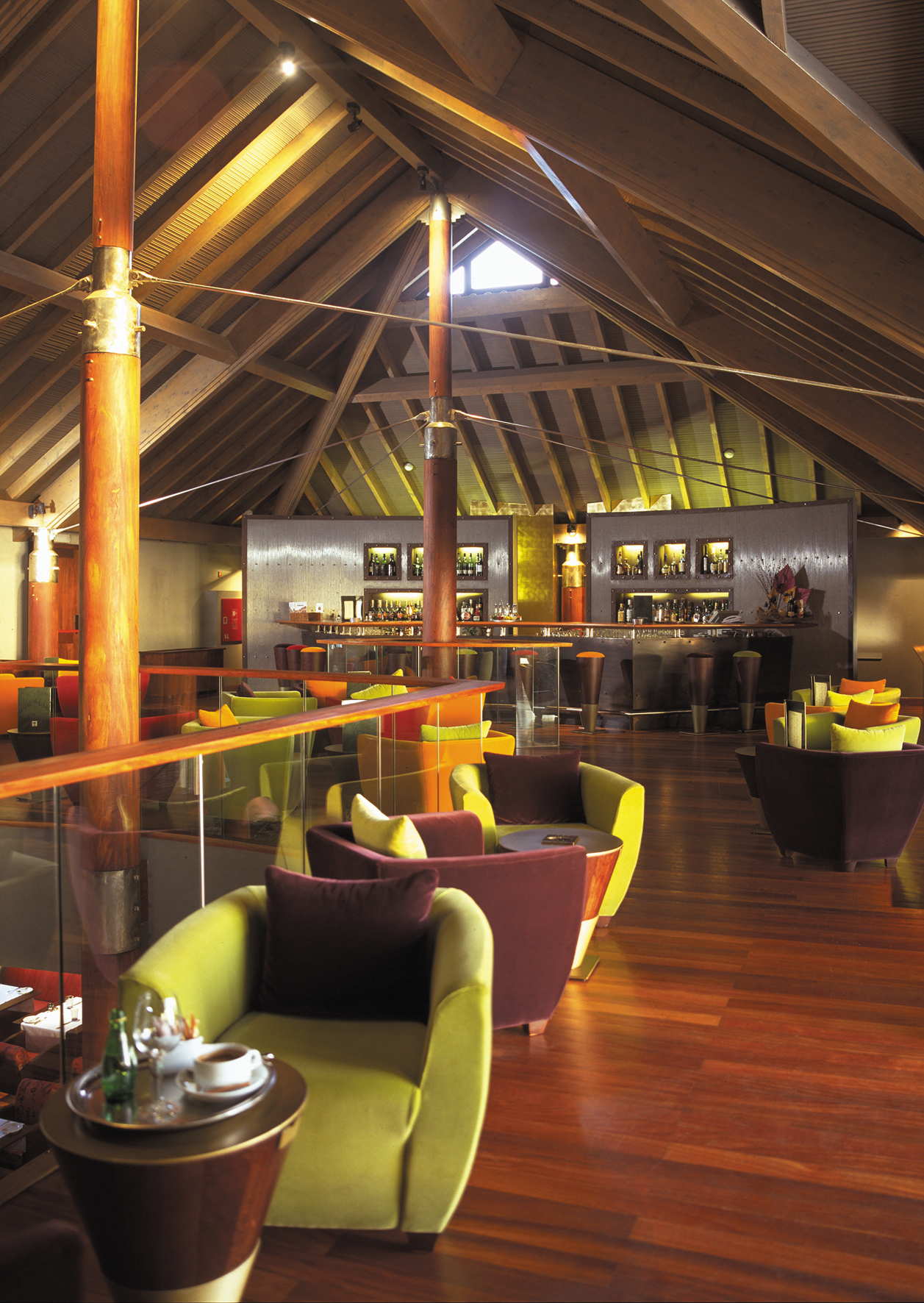 In keeping with the theme of the resort, the cuisine
combines as many Asian as European ingredients in a fusionary style of
great color and flair. We began with an amuse of chestnut puree
and foie gras, the marriage of which was creamy and unexpected good. A tataki of tuna came with Chinese
noodles in ginger sauce, which set up the palate for "crushed" cod with
guacamole on a watercress salad dressed with curry oil, and roasted,
lacquered sea bass with prawns "Chiao-Mian" and teriyaki sauce.
Squab is served with fried corn and popcorn for texture, while a filet
mignon and sweet potato puree with truffles gets a saucing of reduced
Madeira. There is also a vegetarian menu available.
In keeping with the theme of the resort, the cuisine
combines as many Asian as European ingredients in a fusionary style of
great color and flair. We began with an amuse of chestnut puree
and foie gras, the marriage of which was creamy and unexpected good. A tataki of tuna came with Chinese
noodles in ginger sauce, which set up the palate for "crushed" cod with
guacamole on a watercress salad dressed with curry oil, and roasted,
lacquered sea bass with prawns "Chiao-Mian" and teriyaki sauce.
Squab is served with fried corn and popcorn for texture, while a filet
mignon and sweet potato puree with truffles gets a saucing of reduced
Madeira. There is also a vegetarian menu available.For dessert there is roast papaya with mint and lime ice cream, red currant juice laced with Port, and an iced nougat "from the Spice Route" with a piña colada topping.
The winelist shows off the best that Portugal now produces, with, of course, an excellent selection of Madeiras and Ports.
Starters range from 14-32 euros, main courses 22-32 euros.
NEW YORK CORNER
by John Mariani
insieme
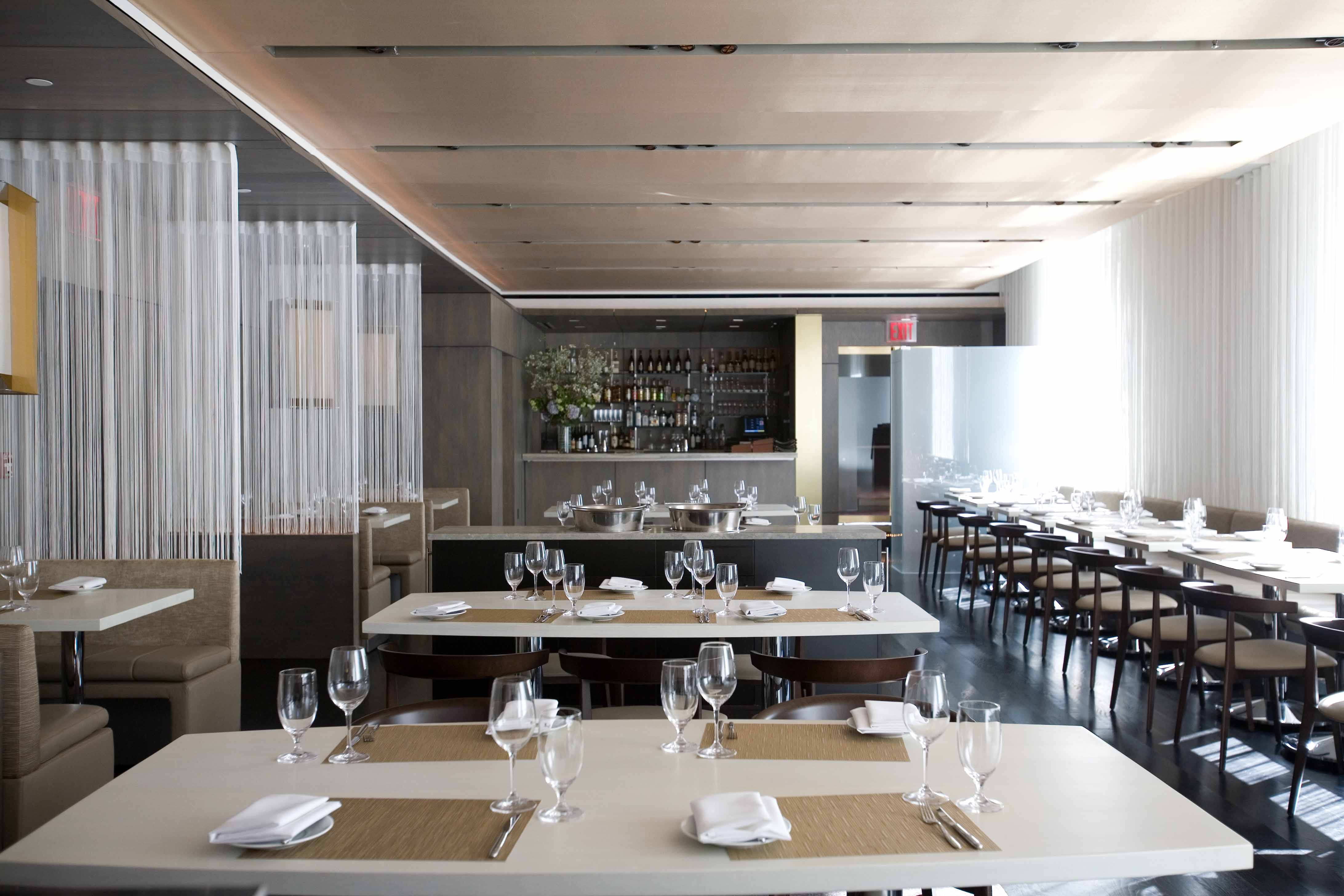
www.restaurantinsieme.com .
We started off with a light fritto misto of offal--calf's liver, sweetbreads, veal, veal tongue, and asparagus--lightly fried to a golden brown crispness, the meat tender and diverse in flavors and textures. Calamari ripieni are stuffed squid, which came with shrimp, sweet white asparagus, ramps, and a little touch of orange that gave them a Southern Italian tang. Canora, with chef de cuisine Edward Higgins, does some Italian sushi, crudi, that might of an evening be salmon belly, yellow tail, Barron Point oysters, or big eye tuna in three variations. They also do a spring bream carpaccio with sugar snap peas, a puree of ramps, and pepper leaves--a burst of springtime on the plate.
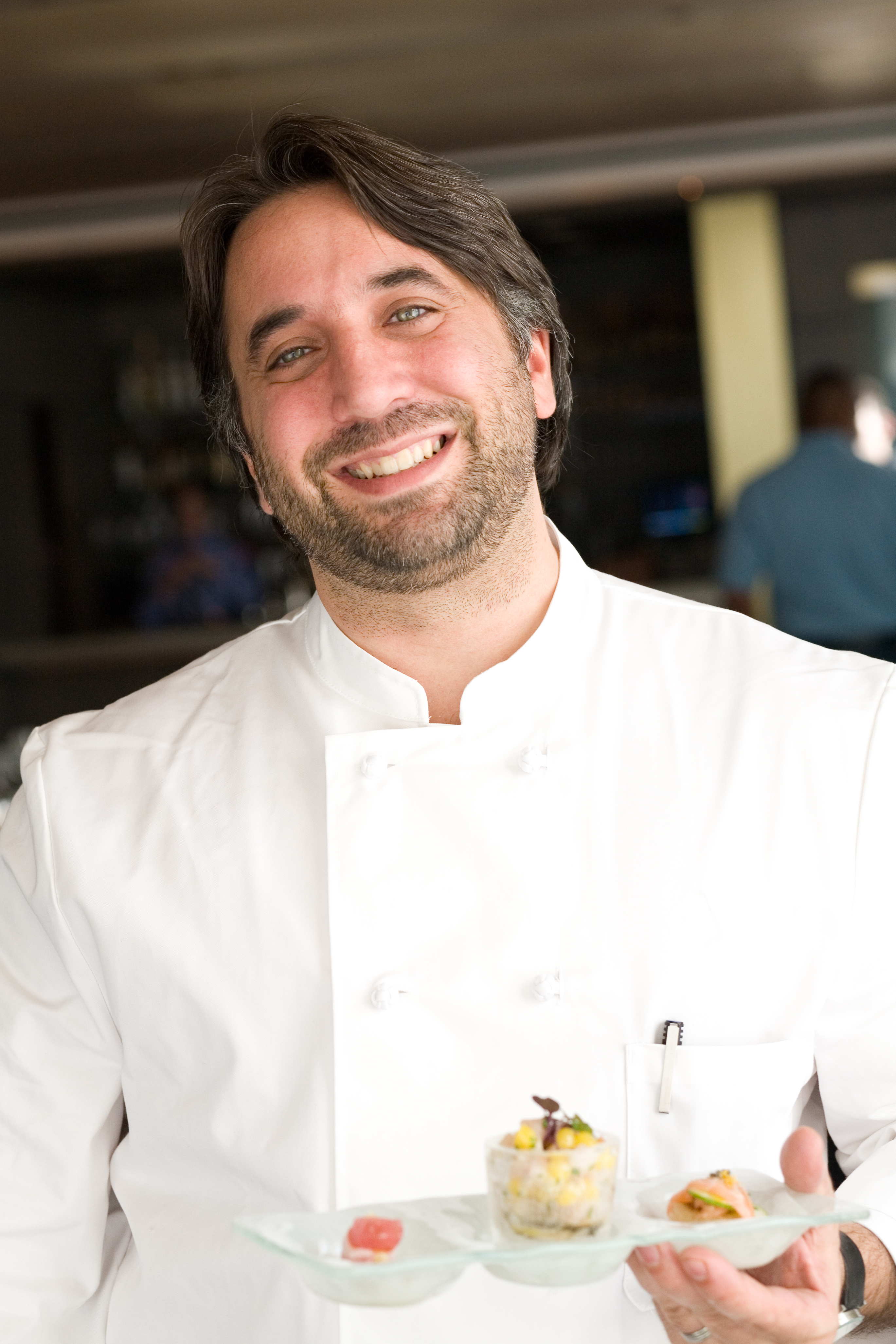 Pastas at Insieme are every bit as lusty as at Hearth,
beginning with one of the best lasagne
alla bologneses I've had
outside of Emilia-Romagna, made with spinach pastas suffused with a besciamella and a ragù
as rich with vegetables as ground meat. Culingionis are Sardinian ravioli,
filled with potato, favas, fennel, and mint--another spot-on
duplication of authenticity and seasonal flavors. Another
dish rarely seen here because it is difficult to get the ingredients
right, is risi e bisi (below), a seemingly simple mess of
rice (not a risotto) and spring peas laced with Parmigiano. Insieme
hits it squarely, making a humble dish sublimely satisfying, with a
touch of prosciutto and celery to perk it up.
Pastas at Insieme are every bit as lusty as at Hearth,
beginning with one of the best lasagne
alla bologneses I've had
outside of Emilia-Romagna, made with spinach pastas suffused with a besciamella and a ragù
as rich with vegetables as ground meat. Culingionis are Sardinian ravioli,
filled with potato, favas, fennel, and mint--another spot-on
duplication of authenticity and seasonal flavors. Another
dish rarely seen here because it is difficult to get the ingredients
right, is risi e bisi (below), a seemingly simple mess of
rice (not a risotto) and spring peas laced with Parmigiano. Insieme
hits it squarely, making a humble dish sublimely satisfying, with a
touch of prosciutto and celery to perk it up.For main courses there is a correctly made cacciucco with shellfish and fish adrift in a sweet tomato sauce sparkling with lemon and peperoncini, in the style of Viarreggio. I always order bollito misto when it's on the menu, and here it is a generously proportioned plate of boiled meats with a salsa verde, horseradish cream, and mustard fruits, just as you'd find it in Modena.
If I have sinned more on the traditional side of the menu, it's for two reasons: First that side had irresistible dishes on it, whereas, second, many of those on the right side seemed strained with disparate flavors, like Tasmanian king salmon (why go to Tasmania for salmon?) with tarragon and salmon caviar, and beef broth with wagyu beef and star anise, which strikes me as wasting very expensive beef when a lesser cut and grade would probably be better in a dish that sounds more Chinese than Italian.
Desserts at Insieme are very, very good, from a really well-made ricotta cheesecake with a hint of orange to a devilishly rich gianduja bar with pistachio-hazelnut cream and orange sauce. Pastry chef Amadou Ly even does a creditable cannoli, spiked with a rhubarb confit. There are also six cheeses available, at $3.50 each.
Insieme would seem to be in a perfect neighborhood to do great business, though its neighbors are not in its class (Pizza Hut is a neighbor), but then again, Le Bernardin, Bar Americain, `21' Club, and Anthos are right around the block. So I think it should do great pre-theater business and attract a crowd that truly loves authentic Italian food in a snappy new setting.
Appetizers run $12-$18, full-course pastas $26, main courses $29-$36, with a 5-course tasting menu at $85.
NOTES FROM THE WINE CELLAR
Choosing
the House Wine
in
by John Mariani
Restaurant photos by Galina Stepanoff-Dargery
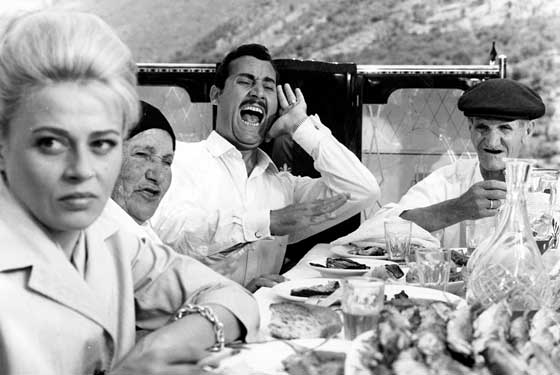 I would rather drink a good beer or
bottled water than a mediocre wine with my meal,
which is why I never, ever
order the house wine anywhere in the world. Except
I would rather drink a good beer or
bottled water than a mediocre wine with my meal,
which is why I never, ever
order the house wine anywhere in the world. Except
I haven’t actually done so in quite a while, for I don’t recall with any degree of pleasure the cheap straw-bottled plonk I drank on student visits to
When I dined in upscale restaurants, I chose my wines from the carta dei vini, trying to spend between 30 to 50 euros. But in the trattorias I stuck to house wines. So, when I found myself in a dot on the
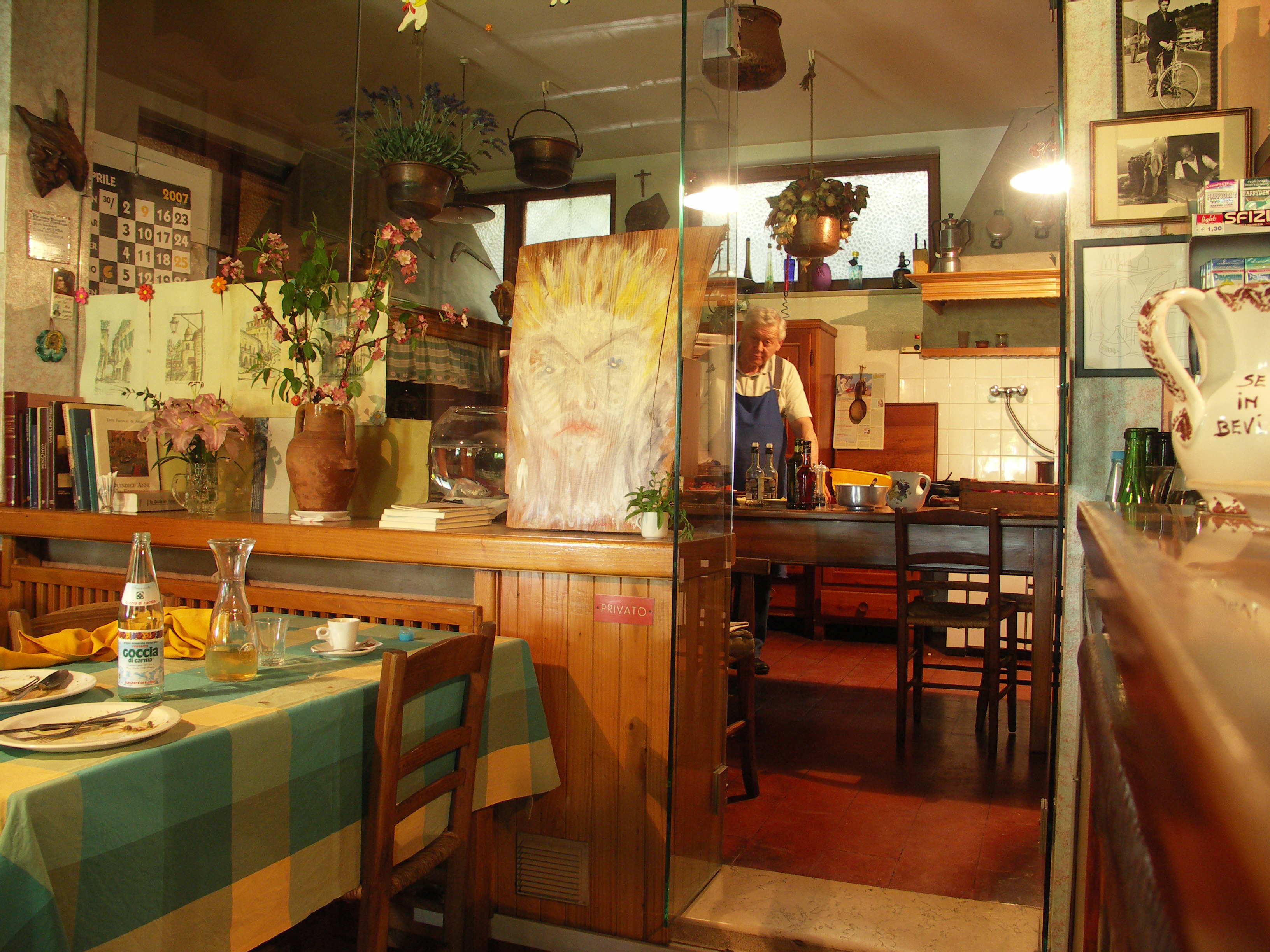
What the heck, I shrugged, and consented to a half carafe. It was absolutely wonderful—sprightly, light in alcohol, with a lemony acidic bite and a very faint sweetness. My four friends and I went through that mezzo-litro than on to another, and another, while feasting on sumptuous platters of salami, soppressata, pickled onions, and hot peppers, mackerel in olive oil, tomatoes and capers, egg frittatas laced with onion, asparagus, tagliatelle with a sweet tomato sauce, and oven-roasted Asiago cheese on country bread. The bill came: The wine came to 16 euros, about $22, and the whole total for food and wine, service and tax, 105 euros ($145).
I would never have ordered the house wine in the
But in
On another day, at a decades’ old trattoria in Rome, near the Spanish Steps, named Le Fric (Via San Nicola da Tolentino 23; 39-06-48-14845), the food was good, hearty, and very Roman—a mix of local cheeses and sausages, spaghetti alla carbonara, and garganelli all’amatriciana. Here they serve the house wine by the glass—a generous pour at about 10 ounces--a delightful Castelli Romani, made from grapes grown in the hills southeast of
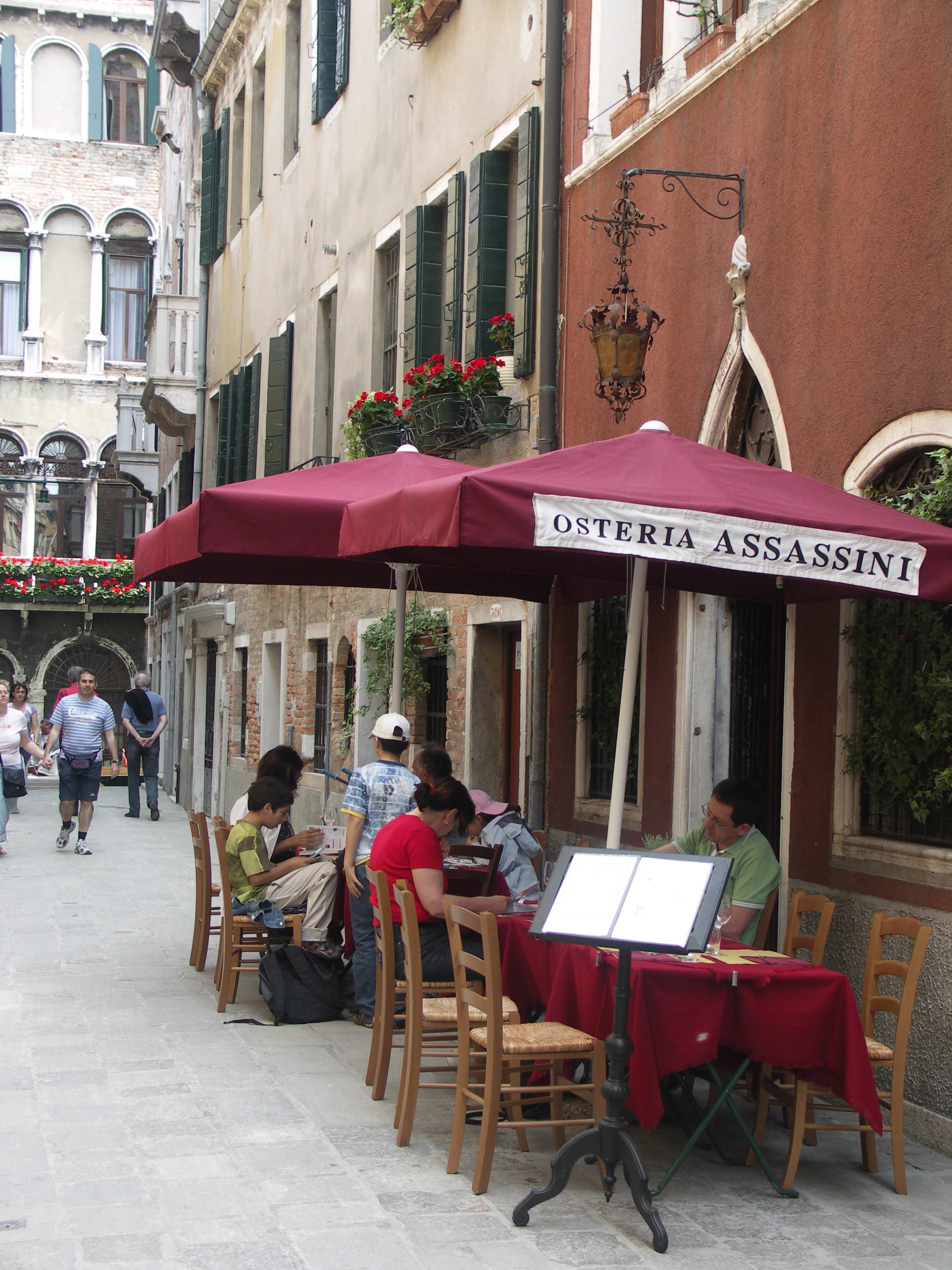 Day by day I increasingly looked forward
to seeing how far the local wines had come, and I was never
disappointed. In
Day by day I increasingly looked forward
to seeing how far the local wines had come, and I was never
disappointed. In 
At my favorite no-frills, never changing eateries in
With the euro so strong and Italian wine prices for well-known labels soaring, my little experiment paid off, not only by saving me a lot of precious U.S. dollars but in showing me that a simple and honest meal goes best with a simple and honest wine.
John Mariani's weekly wine column appears in Bloomberg Muse News, from which this story was adapted. Bloomberg News covers Culture from art, books, and theater to wine, travel, and food on a daily basis, and some of its articles play of the Saturday Bloomberg Radio and TV.
WHO KNEW?
Excerpts from Queens in the Kingdom: the Ultimate Gay & Lesbian Guide to the Disney Theme Parks by Jeffrey Epstein and Eddie Shapiro:
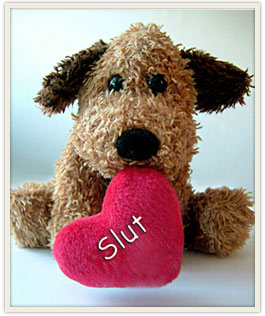
Main Street USA: "The shopping includes stores with one-of-a-kind Disney character watches, hand-blown crystal, magic tricks, embroidered mouse ears (although be warned--they'll only do proper names, so you'll have to be ready to prove that your name is `Slut' if you want it on your hat). . . and a music shop selling CDs of Disney scores and park music. . . . You'd be amazed at how soothing `Yo Ho, A Pirate's Life for Me' can be after a really lousy date."
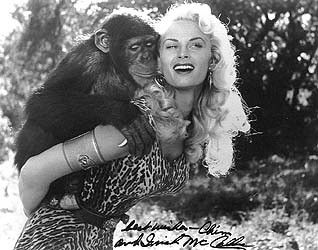
Jungle Cruise: "Each of the boats on the cruise has its own name, including Jungle Princess and the Congo Queen. Who designed this ride?"

Tarzan's Treehouse: "`Too much walking,' groans Billy from Maynard, Massachusetts. `Are you insane?' Andrew from Los Angeles disagrees: `Anytime I can climb into a tree fort with a hot guy wearing nothing but a loincloth, I'm in!'"
 Pirates of
the Caribbean: 'I love that some of the animatronic pirates
seem to have spent a lot of time in Key West, if you know what I mean,"
cracks Bob from Buffalo, NY. `Drunks, prostitutes, and jailbirds,' adds
Donna from Venice, CA. "It's just like Oakland!.'"
Pirates of
the Caribbean: 'I love that some of the animatronic pirates
seem to have spent a lot of time in Key West, if you know what I mean,"
cracks Bob from Buffalo, NY. `Drunks, prostitutes, and jailbirds,' adds
Donna from Venice, CA. "It's just like Oakland!.'"
Chip 'n' Dale Treehouse: "There's nothing gayer in Disneyland than the neat, creatively yet tastefully decorated treehouse where these two young chipmunks share their lives together. . . All they need is a hot tub."
~~~~~~~~~~~~~~~~~~~~~~~~~~~~~~~~~
 DOH!
DOH!
In order to remind him of those halcyon days at Duke University, engineering grad John Cornwell built himself a refrigerator that can toss a can of beer to his couch with the click of a remote control. "It embodies the college spirit that I didn't want to let go of," he told the press. The remote is made from a car's keyless entry device, and a small elevator inside the refrigerator loads the beer can onto a catapult arm, which tosses the beer beer up to 20 feet --"far enough to get to the couch," he said.
QUICK BYTES
*On May 29, Swirl in
* On May 31 at the
* On June 6 in
* On June 14 The Little Nell kicks off this year's Food & Wine Magazine Classic in
* The National Italian American Foundation (NIAF) continues its travel programs to
Everett Potter's Travel Report:
Tennis Resorts Online: A Critical Guide to the World's Best Tennis Resorts and Tennis Camps, published by ROGER COX, who has spent more than two decades writing about tennis travel, including a 17-year stretch for Tennis magazine. He has also written for Arthur Frommer's Budget Travel, New York Magazine, Travel & Leisure, Esquire, Money, USTA Magazine, Men's Journal, and The Robb Report. He has authored two books-The World's Best Tennis Vacations (Stephen Greene Press/Viking Penguin, 1990) and The Best Places to Stay in the Rockies (Houghton Mifflin, 1992 & 1994), and the Melbourne (Australia) chapter to the Wall Street Journal Business Guide to Cities of the Pacific Rim (Fodor's Travel Guides, 1991). Click on the logo below to go to the site.
QUICK BYTES
~~~~~~~~~~~~~~~~~~~~~~~~~~~~~~~~~~~~~~~~~~~~~~~~~~~~~~~~~~~~~~~~~~~~~~~~~
MARIANI'S VIRTUAL GOURMET NEWSLETTER is published weekly. Editor/Publisher:
John Mariani. Contributing Writers: Robert Mariani, Naomi
Kooker, Kirsten Skogerson, Edward Brivio, Mort
Hochstein, Suzanne Wright. Contributing
Photographers: Galina Stepanoff-Dargery, Bobby Pirillo. Technical
Advisor: Gerry McLoughlin.
Any of John Mariani's books below
may be ordered from amazon.com by clicking on the cover image.
 My
newest book, written with my brother Robert Mariani, is a memoir of our
years growing up in the My
newest book, written with my brother Robert Mariani, is a memoir of our
years growing up in the For those of you who don't think of the Robert and I think you'll enjoy this very personal look at our --John Mariani |
 |
 |
 |
 |
 |
 |
copyright John Mariani 2007

